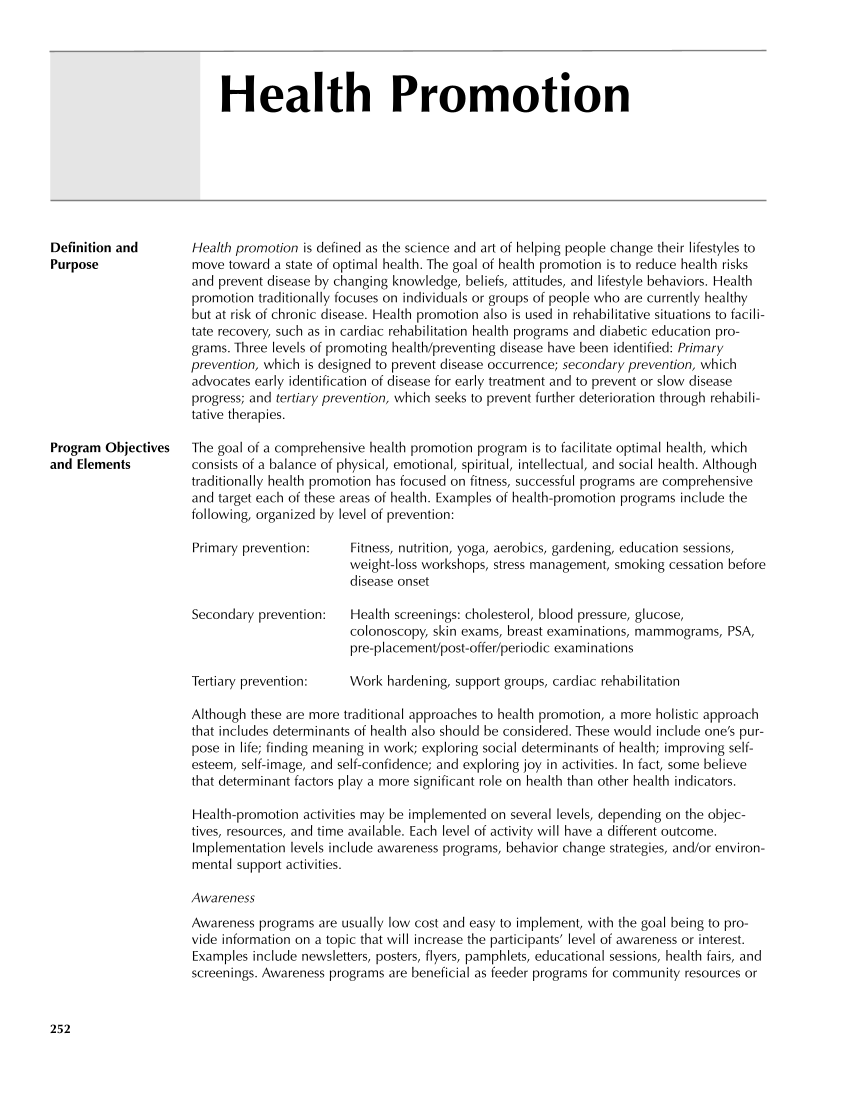Health promotion is defined as the science and art of helping people change their lifestyles to move toward a state of optimal health. The goal of health promotion is to reduce health risks and prevent disease by changing knowledge, beliefs, attitudes, and lifestyle behaviors. Health promotion traditionally focuses on individuals or groups of people who are currently healthy but at risk of chronic disease. Health promotion also is used in rehabilitative situations to facili- tate recovery, such as in cardiac rehabilitation health programs and diabetic education pro- grams. Three levels of promoting health/preventing disease have been identified: Primary prevention, which is designed to prevent disease occurrence secondary prevention, which advocates early identification of disease for early treatment and to prevent or slow disease progress and tertiary prevention, which seeks to prevent further deterioration through rehabili- tative therapies. The goal of a comprehensive health promotion program is to facilitate optimal health, which consists of a balance of physical, emotional, spiritual, intellectual, and social health. Although traditionally health promotion has focused on fitness, successful programs are comprehensive and target each of these areas of health. Examples of health-promotion programs include the following, organized by level of prevention: Primary prevention: Fitness, nutrition, yoga, aerobics, gardening, education sessions, weight-loss workshops, stress management, smoking cessation before disease onset Secondary prevention: Health screenings: cholesterol, blood pressure, glucose, colonoscopy, skin exams, breast examinations, mammograms, PSA, pre-placement/post-offer/periodic examinations Tertiary prevention: Work hardening, support groups, cardiac rehabilitation Although these are more traditional approaches to health promotion, a more holistic approach that includes determinants of health also should be considered. These would include one’s pur- pose in life finding meaning in work exploring social determinants of health improving self- esteem, self-image, and self-confidence and exploring joy in activities. In fact, some believe that determinant factors play a more significant role on health than other health indicators. Health-promotion activities may be implemented on several levels, depending on the objec- tives, resources, and time available. Each level of activity will have a different outcome. Implementation levels include awareness programs, behavior change strategies, and/or environ- mental support activities. Awareness Awareness programs are usually low cost and easy to implement, with the goal being to pro- vide information on a topic that will increase the participants’ level of awareness or interest. Examples include newsletters, posters, flyers, pamphlets, educational sessions, health fairs, and screenings. Awareness programs are beneficial as feeder programs for community resources or 252 Definition and Purpose Program Objectives and Elements Health Promotion
Purchased from OEM Press by (ge corporate access). (C) 2013 OEM Health Information, Inc. All rights reserved.












































































































































































































































































































































































































































